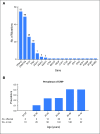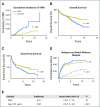Clonal Hematopoiesis Associated With Adverse Outcomes After Autologous Stem-Cell Transplantation for Lymphoma
- PMID: 28068180
- PMCID: PMC5455707
- DOI: 10.1200/JCO.2016.71.6712
Clonal Hematopoiesis Associated With Adverse Outcomes After Autologous Stem-Cell Transplantation for Lymphoma
Abstract
Purpose Clonal hematopoiesis of indeterminate potential (CHIP) is an age-related condition characterized by somatic mutations in the blood of otherwise healthy adults. We hypothesized that in patients undergoing autologous stem-cell transplantation (ASCT) for lymphoma, CHIP at the time of ASCT would be associated with an increased risk of myelodysplastic syndrome and acute myeloid leukemia, collectively termed therapy-related myeloid neoplasm (TMN), and other adverse outcomes. Methods We performed whole-exome sequencing on pre- and post-ASCT samples from 12 patients who developed TMN after autologous transplantation for Hodgkin lymphoma or non-Hodgkin lymphoma and targeted sequencing on cryopreserved aliquots of autologous stem-cell products from 401 patients who underwent ASCT for non-Hodgkin lymphoma between 2003 and 2010. We assessed the effect of CHIP at the time of ASCT on subsequent outcomes, including TMN, cause-specific mortality, and overall survival. Results For six of 12 patients in the exome sequencing cohort, mutations found in the TMN specimen were also detectable in the pre-ASCT specimen. In the targeted sequencing cohort, 120 patients (29.9%) had CHIP at the time of ASCT, which was associated with an increased rate of TMN (10-year cumulative incidence, 14.1% v 4.3% for those with and without CHIP, respectively; P = .002). Patients with CHIP had significantly inferior overall survival compared with those without CHIP (10-year overall survival, 30.4% v 60.9%, respectively; P < .001), including increased risk of death from TMN and cardiovascular disease. Conclusion In patients undergoing ASCT for lymphoma, CHIP at the time of transplantation is associated with inferior survival and increased risk of TMN.
Figures



Comment in
-
Precancerous Clonal Expansion: A New Therapeutic Target?J Clin Oncol. 2017 May 10;35(14):1503-1505. doi: 10.1200/JCO.2017.72.2868. Epub 2017 Mar 14. J Clin Oncol. 2017. PMID: 28291387 No abstract available.
References
MeSH terms
Substances
Grants and funding
LinkOut - more resources
Full Text Sources
Other Literature Sources
Medical

